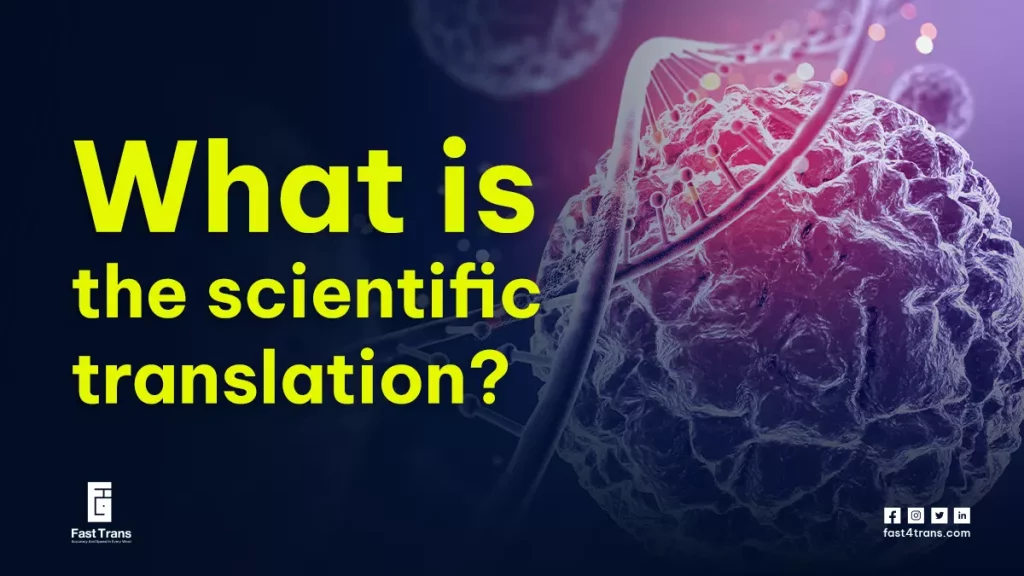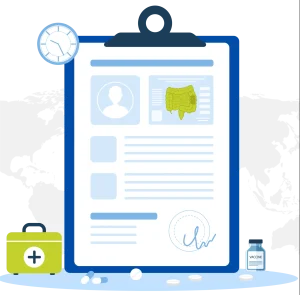Arabic scientific translation bridges the knowledge gap by accurately converting complex academic and technical content into Arabic, making global scientific discoveries accessible to Arabic-speaking communities. It empowers researchers with new perspectives, fosters cross-cultural collaboration, and enhances innovation.
Translators must master both the language and scientific terminology to preserve meaning, using techniques like precise rephrasing and careful handling of symbols. This process ensures that critical scientific information is clearly communicated, driving progress and expanding the reach of global research within the Arab world.
What is the Arabic Scientific Translation?
The process of translating academic, scientific, and technical material into Arabic is known as Arabic scientific translation. A solid understanding of the terms and concepts used in the scientific documents being translated is crucial, as specific fields require highly accurate translation.
The goal of Arabic scientific translation is to make these documents accessible to Arabic-speaking communities, ensuring that people from different cultures can benefit from the knowledge and discoveries in various scientific fields.
The importance of Arabic Scientific Translation
Arabic scientific translation bridges the knowledge gap by providing Arabic-speaking researchers access to global discoveries, fostering innovation and collaboration. It enhances research by offering diverse cultural perspectives and expanding the reach of scientific progress in the Arab world.
1. Reduce the knowledge gap
Arabic scientific translation helps to reduce the knowledge gap that may occur due to language differences. When translation is done accurately, Arabic-speaking scholars and researchers can access and understand critical scientific information related to a particular topic, and connect it with new discoveries made globally. This ensures that scientific progress is accessible to the Arabic-speaking world, bridging the gap between regional and global knowledge.
2. Get new perspectives
When scholars and researchers search for a specific topic, Arabic scientific translation allows them to view it through the lens of different cultures and languages. This multi-lingual access helps them gain fresh insights, leading to more comprehensive research and greater opportunities for innovation within the Arab world, while also fostering cross-cultural scientific collaborations.
3. Easy access to information
Arabic scientific translation makes it possible for Arabic-speaking individuals to access scientific materials and research articles in multiple languages. This is particularly important for students, researchers, and professionals in the Arab world, as it ensures they have the information they need, regardless of the original language of the research, thus facilitating further study and knowledge expansion.
4. Extending the impact of scientific investigation
Arabic scientific translation plays a crucial role in extending the reach and impact of scientific research in the Arab world. By translating scientific books and research papers into Arabic, researchers gain access to a broader range of reliable studies. This significantly enhances the quality of their own work, as they can utilize international research, collaborate more effectively, and contribute to scientific advancements in the Arab-speaking community.
Read more: Cognitive Debriefing in Linguistic Validation
Arabic Scientific Translation techniques
Arabic scientific translation requires precision, clarity, and an in-depth understanding of both language and science. Techniques include careful rephrasing, handling terminology and symbols accurately, and regular exposure to scientific literature to maintain accuracy and coherence in the translated content.
1. Conciseness and Clarity in Translation
Accurately conveying meaning while ensuring clarity is crucial in Arabic scientific translation. The translator must carefully assess whether words and phrases carry the same meaning in the original language as they do in Arabic. Given the complexity of the Arabic language, which is rich in nuance, the translator must ensure that no meaning is lost in the process.
It should be noted that this is not a simple task. To translate scientific terminology into Arabic without distorting the meaning, the translator needs to be highly trained, possess a strong scientific background in the relevant field, and be familiar with Arabic scientific terminology.
2. Dealing with Content Issues
The translator may encounter errors in the source text, but recognizing these errors requires not only linguistic proficiency in both the source language and Arabic but also a scientific understanding of the subject matter. In Arabic scientific translation, any mistake in the source text can lead to further translation inaccuracies. Therefore, it is essential for the translator to have a solid background in both the science and the Arabic language, as this enables them to identify and correct errors effectively.
3. Rephrasing Without Changing Meaning
In Arabic scientific translation, linguistic features and grammatical structures differ significantly from those of the source language. As a result, the translator might need to restructure sentences or rephrase certain terms to ensure that the translated text flows naturally in Arabic without altering the original meaning. This process is vital for maintaining the integrity of the scientific content while ensuring that it is appropriately conveyed in Arabic.
This rephrasing also allows the translator to link ideas and concepts in a manner that feels natural in Arabic, which might require a deep understanding of how scientific topics are typically discussed in Arabic literature.
4. Regular Reading
To enhance their translation skills, an Arabic scientific translator should read a wide range of Arabic scientific literature, research papers, academic articles, and textbooks regularly. This exposure to diverse scientific writing in Arabic helps the translator familiarize themselves with the latest terminology and linguistic trends in the scientific field. Regular study of scientific materials also streamlines the process of Arabic scientific translation by enhancing the translator’s ability to produce error-free and accurate translations.
5. Attention to Terminology, Symbols, and Numbers
Arabic scientific translation often involves working with numbers, symbols, formulas, and diagrams. These elements are integral to scientific documents and must be handled with care. Failing to accurately translate or transfer any of these components could result in a significant alteration of the meaning or scientific accuracy of the text. The translator must ensure that every symbol, term, and number is appropriately rendered in Arabic, adhering to scientific conventions in Arabic-speaking countries.
6. Post-Translation Review
After completing the translation, the translator must thoroughly review the Arabic scientific text to ensure that it is accurate and error-free. This review process is particularly important in the context of Arabic scientific translation, as even minor errors can impact the clarity or accuracy of the content. Once the translator has reviewed the text, it should be passed on to another qualified Arabic scientific translator with expertise in the relevant field for a second review, ensuring that all translation issues are addressed before the final version is produced.
Read more about: What is Arabic Cultural Localization?
Challenges of Arabic Scientific Translation
Translators face several challenges when translating scientific works into Arabic; these are some of the most prominent:
- The presence of complex terms in the source language that are difficult to translate into Arabic, as some scientific concepts may not have direct equivalents in the language.
- The translator must have extensive scientific knowledge in various fields, particularly the subject they are translating, and be familiar with all the relevant terms in both Arabic and the source language.
- Maintaining the structure of the original text while translating into Arabic; scientific articles often contain strict and technical language, and the translator must ensure that the translation remains coherent while preserving the meaning and flow of the content in Arabic.
Read more about: Professional Arabic book translation services
Steps of Arabic Scientific Translation
Arabic scientific translation involves thorough research, careful examination, and precise adaptation of terminology to ensure accuracy. It includes stages like comprehension, translation, linguistic validation, and final review to maintain clarity and scientific integrity.
1. Initial Investigation Before Translation
Before beginning the translation of a scientific text or study into Arabic, the translator must conduct thorough research on the subject matter and familiarize themselves with the relevant terms in both the source language and Arabic. A deep understanding of the field of study and the scientific terminology used in Arabic is essential to ensure an accurate and precise translation.
2. Examining the Written Material
After conducting the necessary research, the translator should read the text multiple times to fully comprehend its meaning and scientific terminology. This step is vital for ensuring the integrity of the original concepts and terminology when transferring them into Arabic. Familiarity with Arabic scientific terms and ensuring they are suitable for the context is crucial during this stage.
3. The Text’s Translation
The actual translation process begins after the translator has ensured they understand all of the scientific terms, symbols, and numbers. If any terms are unclear, they must be looked up in Arabic-language scientific dictionaries or reliable online sources. The translator then proceeds to render the text into Arabic, carefully interpreting and adapting all terms, symbols, and numbers to their correct equivalents in the Arabic language.
4. Examine the Translation
After completing the initial translation, the translator revisits the text to examine its flow, clarity, and coherence in Arabic. This step ensures that the translated sentences make sense, maintain the integrity of the original meaning, and that the scientific terms and concepts are accurately conveyed in Arabic. The correct interpretation of numbers, symbols, and their meanings in Arabic must be carefully verified.
5. Linguistic and Grammar Validation of the Text
This stage is crucial in Arabic scientific translation because the Arabic language has its own grammatical rules and structures that must be respected. The translator ensures that the translation adheres to proper grammar, syntax, and linguistic accuracy in Arabic. Any errors in grammar, spelling, or sentence structure must be corrected immediately, as even small mistakes can alter the meaning of the text.
6. Verify the Accuracy of the Translation
This step is focused on ensuring the quality and accuracy of the Arabic translation. It involves reviewing the translation to ensure it preserves the scientific concepts, terminology, and structure of the original text. The translation must be coherent, clear, and aligned with the expectations of Arabic-speaking readers in the scientific community.
7. Final Review Before Delivery
The final review is the last step before delivering the translated text. This includes a comprehensive check for any remaining scientific, linguistic, or grammatical errors in the Arabic translation. The translator ensures that all terms and meanings are accurately translated. Once this step is complete, it is recommended to have another Arabic-speaking translator with expertise in the field review the text to ensure the translation’s accuracy, quality, and correctness.
The skills an Arabic scientific translator should have
An Arabic scientific translator must possess deep expertise in both the subject matter and the target language, ensuring accurate, precise translations. They should translate efficiently, maintaining clarity and preserving the integrity of the original scientific content.
1. Profound understanding and extensive expertise in the translation field
To ensure accurate and thorough translation, the Arabic scientific translator needs to possess in-depth knowledge and substantial experience in the subject matter, especially considering the technical and specialized terminology used in scientific texts.
2. Master the source and target translation language
The translator must have a strong command of both the source language (whether it’s English, French, etc.) and the Arabic language. This includes not only understanding the scientific terms in the original language but also being able to render them accurately into Arabic, taking into account the different meanings and nuances specific to the Arabic language and scientific discourse.
3. Translate in a concise and orderly manner while preserving the meaning of the text
During the translation process, the Arabic scientific translator must avoid unnecessary additions or omissions and ensure that the translation is concise and clear. The translator must rewrite the text in Arabic in an organized, precise manner while preserving the original meaning, ensuring that the scientific content is accurately conveyed without altering its intent or clarity.
How could fast-trans translation help you with Arabic Scientific Translation?
A lot of people mistakenly believe that anyone can translate scientific material accurately and properly. At Fast-trans, we are committed to providing you with the best professional translators with extensive experience in scientific fields, so you can be sure that the translation you receive is accurate and of the highest caliber.
Additionally, we assist you with translation through a variety of methods that set us apart from other professionals in this sector, the most notable of which are:
- We provide multilingual scientific translation services.
- Our translators have scientific experience that enables them to translate texts accurately and correctly.
- The process of reviewing our texts is carried out by experts specializing in scientific fields.
- We offer competitive translation rates and premium packages.
- You get a high-quality scientific translation.
In the end, if you are looking for a translator who provides you with scientific translation services accurately and correctly, fast-trans is the best place to help you in this and guarantees you a high-quality and accurate translation. As we have explained to you, this translation does not need an ordinary translator; you need a professional and experienced translator in the scientific field, such as fast-trans translators.
Conclusion
Arabic scientific translation involves accurately converting academic, technical, and scientific texts into the Arabic language. This process requires a deep understanding of scientific concepts and terminology, as well as proficiency in both the source and target languages. The goal is to make scientific knowledge accessible to Arabic-speaking communities, enabling researchers and professionals to benefit from global advancements in various fields. Effective translation ensures that complex ideas and discoveries are clearly conveyed, fostering innovation and cross-cultural collaboration.
The importance of Arabic scientific translation lies in its ability to bridge the knowledge gap, offering Arabic-speaking researchers access to critical scientific information. It facilitates the exchange of ideas, enabling them to gain new perspectives and collaborate globally. Translators must possess specialized knowledge in both science and language, using techniques like precise terminology handling, rephrasing, and regular exposure to scientific literature. By accurately transferring symbols, formulas, and concepts, Arabic scientific translation enhances research quality and extends the impact of global discoveries within Arabic-speaking communities.











